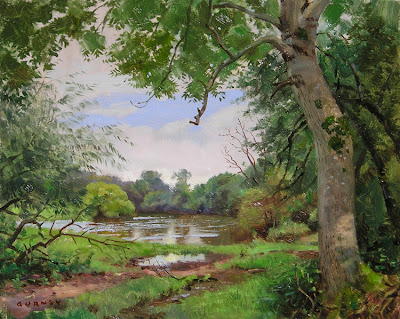
But other forms are feathery and delicate. Think of the leaves of a willow tree, the wispy texture of a cirrus cloud, or the waving tassels of a wheatfield. These call for pianissimo painting.

Here’s the view past my easel. I was standing at the river’s edge near Clonmel, Ireland. It was an unusual vista, with intricate foliage framing a light sky. There were no simple blocky masses of tone. Instead there were lots of slender twigs, and there were layers upon layers of leaves.

After a thinly stated preliminary lay-in, I painted the sky with just a thin veil of pale whites and blues. For the willow leaves (detail, above) I dragged a large bristle brush very lightly over the sky to suggest a lot of leaves without actually painting them one by one. I then added a few small strokes at the edge of the mass using a round sable.
The same is true of the upper fringe of foliage. I blocked the big masses of foliage with a large square brush and then added a fringe of individual leaves with a smaller brush. The goal is to give the impression that you’re seeing more detail than is actually stated.

The final painting is 8x10 inches, painted in one session of about three hours. Most of the detail is hinted at. The key to this kind of painting is to use the biggest brushes you can, but to use them very lightly, dragging and scumbling. Then in a few areas, you can use tiny brushes to suggest the most delicate forms.
P.S. Thanks to Kim Barker of LakeTrees for listing GurneyJourney as the #7 Artist's Blog and thanks to everybody who has linked.
Tomorrow: Matania—Without a Net
Không có nhận xét nào:
Đăng nhận xét